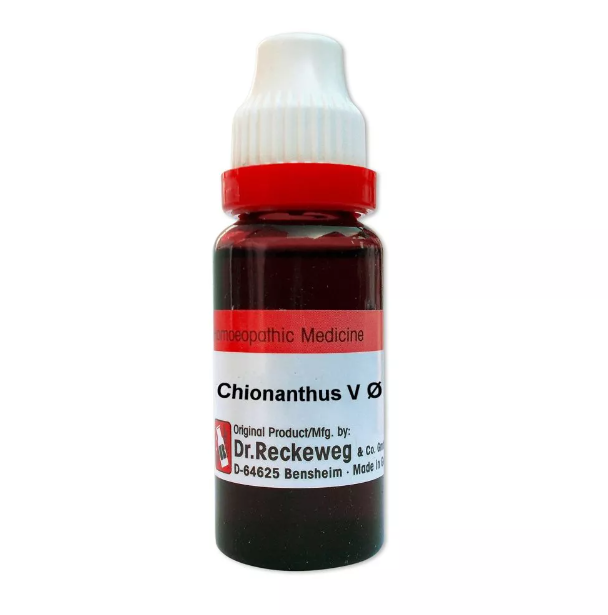CHIONANTHUS VIRGINICA Q, 6C, 12C, 30C, 200C, 1M, 10M USES AND SYMPTOMS
 CHIONANTHUS VIRGINICA
CHIONANTHUS VIRGINICA
(Fringe Tree)
This remedy is useful for various types of headaches, including neurasthenic, periodical, sick, menstrual, and bilious. Regular use for several weeks in drop doses can often prevent sick headaches. Symptoms include pain in the forehead, especially over the eyes, and painful eyeballs with pressure over the root of the nose. It is effective for liver issues such as jaundice and enlarged spleen, jaundice with menstrual arrest, gallstones, diabetes mellitus, and paroxysmal abdominal pain.
Head: The patient feels listless and apathetic with a dull frontal headache over the root of the nose, eyes, and temples, which worsens with stooping, motion, or jarring. Yellow conjunctiva is present (indicating jaundice).
Mouth: There is a persistent dry sensation not relieved by water and profuse saliva. The tongue appears broad with a thick yellow coating.
Abdomen: The patient experiences aching in the umbilical region and griping pain, feeling as if a slip knot is tightening and loosening around the intestines. The abdomen is sore and enlarged, accompanied by jaundice and constipation. Stools are clay-colored or soft, yellow, and pasty. The tongue is heavily coated, appetite is absent, and bilious colic and tenderness in the hepatic region are present. Pancreatic disease and other glandular disorders may also occur.
Urinary: The urine has high specific gravity, frequent urination, and contains bile and sugar, appearing very dark.
Skin: The skin is yellow, moist, sallow, greenish, and itchy.
Relationship: Compare with Chin., Cean., Chel., Card-m., Podo., Lept.
Dose: Tincture and first attenuation.
SYMPTOMS OF CHIONANTHUS VIRGINICA
Head:
Pain in the forehead, especially over the eyes
Painful eyeballs with pressure over the root of the nose
Listlessness and apathy
Dull frontal headache over the root of the nose, eyes, and temples
Headache worsens with stooping, motion, or jarring
Yellow conjunctiva (indicative of jaundice)
Mouth:
Persistent dry sensation not relieved by water
Profuse saliva
Broad tongue with a thick yellow coating
Abdomen:
Aching in the umbilical region
Griping pain
Sensation of a slip knot tightening and loosening around the intestines
Soreness and enlargement with jaundice and constipation
Clay-colored stool or soft, yellow, and pasty stool
Heavily coated tongue
Lack of appetite
Bilious colic
Tenderness in the hepatic region
Pancreatic disease and other glandular disorders
Urinary:
High specific gravity of urine
Frequent urination
Presence of bile and sugar in the urine
Very dark urine
Skin:
Yellow coloration
Marked moisture
Sallow, greenish hue
Itchiness
selection of the potency
Individualization:
- Homeopathy is based on the principle of treating the individual, not just the disease. The unique symptoms and characteristics of the person are crucial in determining the most suitable potency.
Intensity of Symptoms:
- The intensity of the symptoms guides the choice of potency. If the symptoms are intense and acute, a lower potency (e.g., 6C, 30C) might be considered. For chronic conditions with less intensity, higher potencies (e.g., 200C, 1M) may be appropriate.
Sensitivity of the Patient:
- Some individuals are more sensitive to homeopathic remedies, while others may require higher potencies. The practitioner considers the patient’s sensitivity when selecting the potency.
Acute vs. Chronic Conditions:
- Lower potencies are often used for acute conditions, while higher potencies may be considered for chronic or long-standing issues.
Previous Response to Potencies:
- The patient’s response to previous homeopathic treatments helps guide the choice of potency. If a particular potency has been effective in the past, it may be repeated or adjusted as needed.
Vital Force and Susceptibility:
- Homeopathy views illness as a disturbance in the vital force. The practitioner assesses the patient’s overall vitality and susceptibility to determine the appropriate potency.
Aggravation or Amelioration:
- The direction of the symptom response (aggravation or amelioration) after taking a remedy can influence the choice of potency.
Miasmatic Considerations:
- In classical homeopathy, the concept of miasms (inherited disease tendencies) is considered. The practitioner take this into account when selecting the potency.
Practitioner Experience:
- The experience and preference of the homeopathic practitioner play a role. Some practitioners may have success with certain potencies based on their clinical experience.
SAFETY INFORMATION
- Do not exceed the recommended dose by physician
- Keep out of the reach of children
- Store in a cool dry place away from direct sunlight
- Maintain half an hour gap between food/drink/any other medicines and homoeopathic medicine
- Avoid any strong smell in the mouth while taking medicine e.g. camphor, garlic, onion, coffee, hing
Medicine images use for reference only selection of homeopathic medicine depends on the individual’s specific symptoms and overall constitution. Moreover, homeopathy is a holistic system of medicine that treats the individual as a whole. In addition to addressing the physical symptoms, it takes into account the emotional and mental state of the person. Consequently, it’s crucial to consult with a qualified homeopathic practitioner for personalized treatment.
The information provided on this website is intended solely for educational purposes. Always seek the advice of your physician or other qualified health provider.
